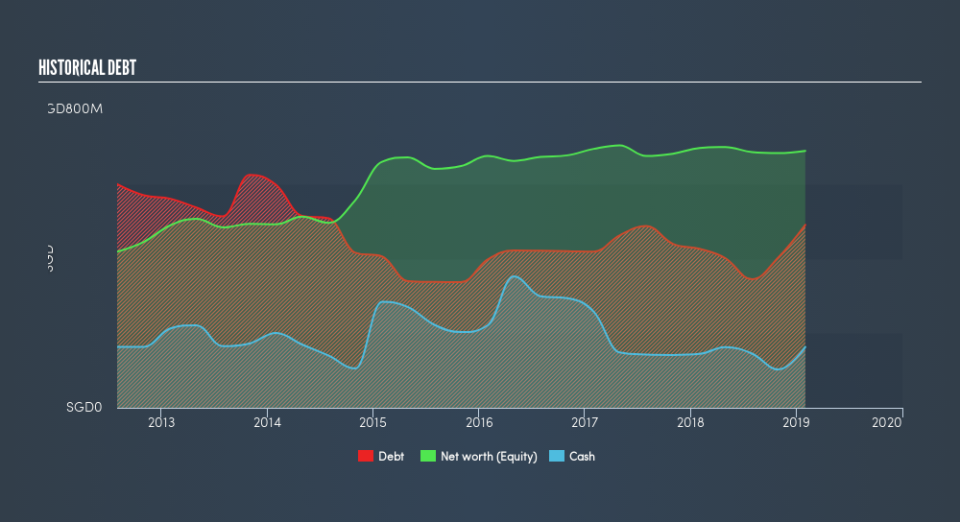Are Low Keng Huat (Singapore) Limited's (SGX:F1E) Interest Costs Too High?

Low Keng Huat (Singapore) Limited (SGX:F1E) is a small-cap stock with a market capitalization of S$399m. While investors primarily focus on the growth potential and competitive landscape of the small-cap companies, they end up ignoring a key aspect, which could be the biggest threat to its existence: its financial health. Why is it important? Evaluating financial health as part of your investment thesis is essential, as mismanagement of capital can lead to bankruptcies, which occur at a higher rate for small-caps. We'll look at some basic checks that can form a snapshot the company’s financial strength. However, potential investors would need to take a closer look, and I suggest you dig deeper yourself into F1E here.
Want to participate in a short research study? Help shape the future of investing tools and you could win a $250 gift card!
F1E’s Debt (And Cash Flows)
F1E's debt levels surged from S$426m to S$490m over the last 12 months , which accounts for long term debt. With this growth in debt, F1E's cash and short-term investments stands at S$163m , ready to be used for running the business. Its negative operating cash flow means calculating cash-to-debt wouldn't be useful. As the purpose of this article is a high-level overview, I won’t be looking at this today, but you can examine some of F1E’s operating efficiency ratios such as ROA here.
Can F1E meet its short-term obligations with the cash in hand?
Looking at F1E’s S$137m in current liabilities, it appears that the company has maintained a safe level of current assets to meet its obligations, with the current ratio last standing at 3.37x. The current ratio is the number you get when you divide current assets by current liabilities. However, a ratio greater than 3x may be considered by some to be quite high, however this is not necessarily a negative for the company.
Is F1E’s debt level acceptable?
F1E is a relatively highly levered company with a debt-to-equity of 71%. This is somewhat unusual for small-caps companies, since lenders are often hesitant to provide attractive interest rates to less-established businesses. We can test if F1E’s debt levels are sustainable by measuring interest payments against earnings of a company. Ideally, earnings before interest and tax (EBIT) should cover net interest by at least three times. For F1E, the ratio of 16.89x suggests that interest is comfortably covered, which means that debtors may be willing to loan the company more money, giving F1E ample headroom to grow its debt facilities.
Next Steps:
Although F1E’s debt level is towards the higher end of the spectrum, its cash flow coverage seems adequate to meet obligations which means its debt is being efficiently utilised. Since there is also no concerns around F1E's liquidity needs, this may be its optimal capital structure for the time being. I admit this is a fairly basic analysis for F1E's financial health. Other important fundamentals need to be considered alongside. You should continue to research Low Keng Huat (Singapore) to get a more holistic view of the small-cap by looking at:
Future Outlook: What are well-informed industry analysts predicting for F1E’s future growth? Take a look at our free research report of analyst consensus for F1E’s outlook.
Historical Performance: What has F1E's returns been like over the past? Go into more detail in the past track record analysis and take a look at the free visual representations of our analysis for more clarity.
Other High-Performing Stocks: Are there other stocks that provide better prospects with proven track records? Explore our free list of these great stocks here.
We aim to bring you long-term focused research analysis driven by fundamental data. Note that our analysis may not factor in the latest price-sensitive company announcements or qualitative material.
If you spot an error that warrants correction, please contact the editor at editorial-team@simplywallst.com. This article by Simply Wall St is general in nature. It does not constitute a recommendation to buy or sell any stock, and does not take account of your objectives, or your financial situation. Simply Wall St has no position in the stocks mentioned. Thank you for reading.

